|
WHITMAN MISSION National Historic Site |
 |
The Harvest of Violence
With the exception of David Main and the two Manson boys, whom the Indians allowed to go to Fort Walla Walla, they held all 49 survivors captive at Waiilatpu. Although most of them suffered greatly from shock and were fearful of the future, most of the captives were not treated severely. Three of the older girls were singled out by Indians who desired them for wives. Especially maltreated was Lorinda Bewley who was subjected to the unwanted attentions of Five Crows, a chief who had not participated in the attack and who had long enjoyed many favors from the Whitmans. During their captivity, two young girls died—Louise Sager and Helen Mar Meek. Both these children had been critically ill with measles before the massacre, and it is possible they would have died even with Dr. Whitman present to care for them.
On Tuesday, the day following the attack, Joe Stanfield dug a shallow, mass grave near the mission cemetery north of the mission house. On the same day, Father Brouillet, one of the priests whose arrival in the vicinity a few weeks earlier had so greatly disturbed Dr. Whitman, reached Waiilatpu. Horrified by the scene of death and destruction, Brouillet helped Stanfield prepare the dead. Rendering "to those unfortunate victims the last service in my power to offer them," Brouillet officiated at the burial. A few days later wild animals disturbed the shallow grave, and it had to be covered again. In March 1848 the remains, which again had been disturbed by wolves, were placed in a new grave and covered with an upturned wagon bed by the Oregon Volunteers. On the 50th anniversary of the massacre, the bodies were disinterred and reburied in a more fitting tomb, where they lie today.

The second great grave, where the Oregon Volunteers buried the massacre victims in 1848.
 Peter Skene Ogden. |
News of the massacre reached Fort Vancouver early in December. Moving quickly, Chief Factor James Douglas sent Peter Skene Ogden up the Columbia with a supply of goods to bargain for the release of the captives. On December 29, one month after the massacre, the prisoners were exchanged for 62 blankets, 63 shirts, 12 guns, 600 loads of ammunition, 37 pounds of tobacco, and 12 flints.
None of the other American Board missions were attacked. On January 1, 1848, the Nez Percé escorted the Spaldings to Fort Walla Walla, where they joined the 49 Waiilatpu survivors for the journey to Willamette. The Eellses and Walkers continued to live among the Spokan until the following spring when they, too, left for Oregon City. Thus the activities of the American Board came to an end in the Pacific Northwest.
When Gov. George Abernethy, head of the provisional government in Oregon Territory, heard of the massacre, a company of riflemen was enrolled to punish the Cayuse. Soon the call was increased to 500 volunteers. At the end of February the volunteer soldiers reached the Walla Walla Valley. The Cayuse fled to the mountains north of the Snake River, but the disorganized and poorly disciplined troops did not pursue them far. These volunteers stayed at Waiilatpu until early summer. Then, leaving behind a guard of 50 men at the mission—by now called Fort Waters—the rest returned home.
After 2 years of wandering and hardships, the Cayuse gave up five of their men in an effort to make peace with the whites. These five were arrested for murder and tried by jury in Oregon City. All five were found guilty (although one of them probably took no part in the massacre) and were hanged in 1850. There is bitter irony in the fact that the hangman was Joe Meek, the father of Helen Mar. The Indians' problems were not solved by the hanging. In fact, the time of troubles was just starting. For the next generation intermittent Indian wars plagued the Pacific Northwest; but the Cayuse were never again a source of real trouble.
At the time that he dispatched the Oregon Volunteers, Governor Abernethy and the provisional legislature sent emissaries to Washington (led by Joe Meek) to call attention to the state of affairs in Oregon. News of the massacre moved Congress to act, and in August 1848 a bill was passed creating the Territory of Oregon. Thus did Marcus and Narcissa Whitman serve the Pacific Northwest and their country after death.
Alive, they had striven to prepare the Cayuse for the civilization that was sure to engulf them. When the emigrants did arrive, the Whitman mission became a haven in the wilderness for these weary wanderers. The Whitmans' deaths had the immediate result of creating the first formal American territorial government west of the Rocky Mountains. Today, the story of the Whitmans serves to inspire all people who would pursue the way of high principles and ideals. Events at Waiilatpu were climaxed with disaster, but from this tragedy there shines a rare courage, dedication, and strength that men will ever need.
|
|

|
|
Last Modified: Sat, Sep 28 2002 10:00:00 pm PDT |


